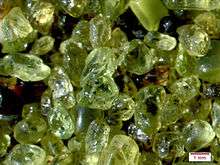MicrOmega-IR
MicrOmega-IR is an infrared hyperspectral microscope that is part of the science payload on board the European Rosalind Franklin rover,[3] tasked to search for biosignatures on Mars. The rover is planned to land on Mars in spring 2023. MicrOmega-IR will analyse in situ the powder material derived from crushed samples collected by the rover's core drill.[4][5]
| Operator | European Space Agency |
|---|---|
| Manufacturer | Institut d'Astrophysique Spatiale, of the CNRS |
| Instrument type | Infrared hyperspectral microscope |
| Function | Subsurface composition |
| Mission duration | ≥ 7 months[1] |
| Website | ExoMars Rover Instrument Suite |
| Properties | |
| Mass | ≈2 kg |
| Host spacecraft | |
| Spacecraft | Rosalind Franklin rover |
| Operator | European Space Agency |
| Launch date | August–October 2022[2] |
| Rocket | Proton-M/Briz-M |
| Launch site | Baikonur |

Development
The MicrOmega mnemonic is derived from its French name Micro observatoire pour la mineralogie, l'eau, les glaces et l'activité;[1] IR stands for infrared. It was developed by France's Institut d'Astrophysique Spatiale at the CNRS. France has also flown MicrOmega on other missions such as the 2011 Fobos-Grunt and the Hayabusa2 MASCOT mobile lander currently exploring asteroid Ryugu.[6] France is also developing a variant called MacrOmega Near-IR Spectrometer for the Martian Moons Exploration (MMX) lander, a Japanese sample-return mission to Mars' moon Phobos.[7]
The Principal Investigator of the MicrOmega-IR for the Rosalind Franklin rover is Jean-Pierre Bibring, a French astronomer and planetary scientist at the Institut d'Astrophysique Spatiale. Co-PIs are astrobiologists Frances Westall and Nicolas Thomas.[8]
MicrOmega was developed by a consortium including:[9]
- IAS (Orsay, France)

- LESIA (Meudon, France)

- CBM (Orléans, France),

- University Of Bern (Bern, Switzerland)

- Russian Space Research Institute (IKI) (Moscow, Russia)

Overview
| MicrOmega-IR | Parameter/units [10] |
|---|---|
| Type | Infrared hyperspectral microscope |
| Manufacturer | Institut d'Astrophysique Spatiale, of the CNRS |
| Spectral range | 0.9–4 μm [11] |
| Spectral sampling | 20/cm from 0.95 μm to 3.65 μm |
| Imaging resolution | 20 μm2/pixel |
| Field of view | 5 × 5 mm2 |
| Mass | ≈ 2 kilograms (4.4 lb) |
MicrOmega-IR is a visible and infrared hyperspectral microscope that is designed to characterize the texture and composition of crushed samples presented to the instrument.[10] Its objective is to study mineral grain assemblages in detail to try to unravel their geological origin, structure and composition, including potential organics.[10] These data will be vital for interpreting past and present geological processes and environments on Mars. Because MicrOmega-IR is an imaging instrument, it can also be used to identify grains that are particularly interesting, and assign them as targets for Raman and MOMA observations.[10]
It is composed of 2 microscopes: MicrOmega/VIS has a spatial sampling of approximately 4 μm, working in 4 colors in the visible range. The other one is the MicrOmega/NIR hyperspectral microscope working in the spectral range 0.95 μm - 3.65 μm with a spatial sampling of 20 μm per pixel.[11] Its main supporting components include:[12]
- A monochromator based on an Acousto-optic modulator illumination system.
- Infrared magnification optics.
- Infrared focal plane.
- The thermal control system.
- The sample container.
The IR instrument uses a HgCdTe (Mercury-Cadmium-Telluride) matrix detector, the Sofradir Mars SW 320 x 256 pixels.[13]
Examples of materials for identification, if present:[14]
- pyroxene
- olivine
- ferric oxides
- hydrated phyllosilicates
- sulfates
- carbonates
- ices
- organics (organic as in organic chemistry)
See also
- Astrobiology
- Life on Mars
- Mars Multispectral Imager for Subsurface Studies (Another ExoMars drill-related instrument)
References
- Vago, Jorge L.; et al. (July 2017). "Habitability on Early Mars and the Search for Biosignatures with the ExoMars Rover". Astrobiology. 17 (6–7): 471–510. Bibcode:2017AsBio..17..471V. doi:10.1089/ast.2016.1533. PMC 5685153. PMID 31067287.
- "N° 6–2020: ExoMars to take off for the Red Planet in 2022" (Press release). ESA. 12 March 2020. Retrieved 12 March 2020.
- Howell, Elizabeth (July 24, 2018). "ExoMars: Searching for Life on Mars". Space.com. Retrieved March 13, 2020.
- Vago, Jorge; Witasse, Olivier; Baglioni, Pietro; Haldemann, Albert; Gianfiglio, Giacinto; et al. (August 2013). "ExoMars: ESA's Next Step in Mars Exploration" (PDF). Bulletin. European Space Agency (155): 12–23.
- Korablev, Oleg I.; et al. (July 2017). "Infrared Spectrometer for ExoMars: A Mast-Mounted Instrument for the Rover" (PDF). Astrobiology. 17 (6–7): 542–564. Bibcode:2017AsBio..17..542K. doi:10.1089/ast.2016.1543. PMID 28731817.
- MicroMega Instrument for MASCOT. CNES, France. August 26, 2016. Accessed: 21 July 2018.
- Martian Moons eXploration (MMX) Mission Overview. (PDF). JAXA. 10 April 2017.
- The ExoMars Rover Instrument Suite - MicrOmega. European Space Agency. Published: 25 August 2017.
- Vaitua, Leroi; Bibring, Jean-Pierre; Berthé, Michel (2017-11-21). "MicrOmega IR: a new infrared hyperspectral imaging microscope or in situ analysis". International Conference on Space Optics — ICSO 2008. 10566. p. 50. doi:10.1117/12.2308234. ISBN 9781510616219.
- The MicrOmega Investigation Onboard ExoMars. Jean-Pierre Bibring, Vincent Hamm, Cédric Pilorget, Jorge L. Vago, and the MicrOmega Team. Astrobiology, Vol. 17, No. 6-7. 1 July 2017. doi:10.1089/ast.2016.1642.
- Leroi, Vaitua; Bibring, Jean-Pierre; Berthe, Michel (2009). "Micromega/IR: Design and status of a near-infrared spectral microscope for in situ analysis of Mars samples". Planetary and Space Science. 57 (8–9): 1068–1075. Bibcode:2009P&SS...57.1068L. doi:10.1016/j.pss.2008.12.014.
- MicrOmega Instrument Prototype. European Space Agency. 12 October 2015.
- Vaitua, Leroi; Bibring, Jean-Pierre; Berthé, Michel (2017-11-21). "MicrOmega IR: a new infrared hyperspectral imaging microscope or in situ analysis". International Conference on Space Optics — ICSO 2008. 10566. p. 50. doi:10.1117/12.2308234. ISBN 9781510616219.
- Leroi, Vaitua; Bibring, Jean-Pierre; Berthe, Michel (July 2009). "Micromega/IR: Design and status of a near-infrared spectral microscope for in situ analysis of Mars samples". Planetary and Space Science. 57 (8–9): 1068–1075. Bibcode:2009P&SS...57.1068L. doi:10.1016/j.pss.2008.12.014. ISSN 0032-0633.
.jpg)